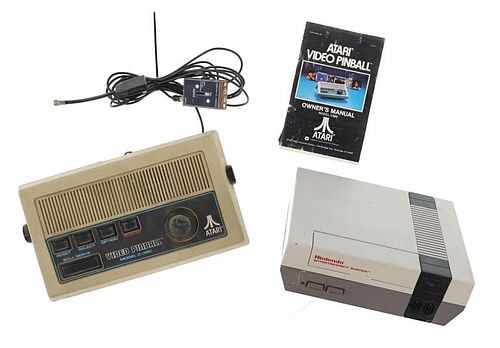For your consideration are two gaming consoles, an Atari Video Pinball Model C-380 and a Nintendo NES-001 circa 1977-1993. The first console, the Atari Video Pinball Model C-380 was first manufactured in 1977. The pinball and breakout concepts form the foundation of the games that are played. The games were controlled by a dial on the front or by bumper controllers on the sides. The ball bounces on two bumpers (in pinball games), on a pad that slides horizontally (in pinpaddle games), or just like in breakout, depending on the game that is chosen. The first was a pinball game with four variations. A few changes were made to the bounce type and graphics. Depending on the variation, you might move a paddle with the knob or use your flippers (via side buttons) to manipulate the ball. A basketball game was the second game. The object of the game was to release the ball into a multicolored basket after it bounced off a pad that moved horizontally. Breakout was the third category of games. Another variation was dubbed Breakway/Breakthru; the only distinction between the two was that the green bricks had been replaced with a hole in the wall. The console's side buttons and knob move freely without getting stuck and the power and game selection buttons are in good condition as well. It reads, "Video Pinball Model C-380 / Atari / Reset, Select, Option, Power, Ball Serve". The console comes with the original owners manual giving instructions on how to start and play, troubleshooting solutions and tips & tricks for the games programmed onto the console. The console comes with the power cord attached. The second console in this lot is the renowned Nintendo NES-001, first manufactured in Japan in 1983 under the name Family Computer or Famicom. The Famicom was introduced to the West by Nintendo on October 18, 1985, and it became the Nintendo Entertainment System, a huge cultural icon that contributed to the revival of the American video game industry. Nintendo made numerous aesthetic and functional improvements to the console, even though it shares the same core technology as the Famicom, to make it more appealing to the American market. After the 1983 market meltdown, many merchants had grown wary of video game consoles. Only a test market, New York City saw the NES's 1985 release; a full North American release followed in the fall of 1986. The term "front loader" comes from the way cartridges are pushed down and loaded into the front behind a flip-up door. In addition, the cartridges were modified, with a significantly larger shape and 72 pins as opposed to the Famicom's 60. The power LED, two 7-pin controller connectors, and the power and reset buttons are all located along the front. The right-hand side features mono audio and composite video outputs, which were uncommon on older gaming consoles. The AC adapter input, channel choose switch, and RF output are located on the back. The console shows good condition overall with some slight cosmetic wear. The internal components appear to be in good condition, just dusty. The Atari Pinball C-380 shows good condition as well with wear from its age and use over the years, but no signs of obvious damage is noted. Power cord appears to be in good condition. Both consoles have not been tested for functionality. The Atari Piball console measures 7 1/2" L x 13 1/2" W x 4 1/4" H, while the Nintendo NES-001 console measures 8" L x 10 1/8" W x 3 1/2" H. The two consoles have a collective weight of 6 pounds.

















